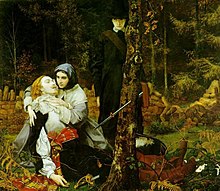William Shakespeare Burton



William Shakespeare Burton (1 June 1824 – 26 January 1916) was an English genre and historical painter of the Victorian era. He is now remembered mainly for The Wounded Cavalier (1855).
Life
Burton's grandfather was a printer, and his father was William Evans Burton, a comic actor and playwright who found popular success in the United States — while leaving his wife and son behind in London, with little money. An only child, the younger Burton worked at copying prints as a teenager. The dramatist and critic Tom Taylor was his sponsor and patron. Taylor helped the teen find work at the magazine Punch, a job designing capitals for illustrations (which provided much-needed income).
He was educated at
To paint his most famous work, The Wounded Cavalier, Burton was said to have dug a hole in the ground to stand in, so that he could paint the grass and ferns at eye level.
The Wounded Cavalier was the artist's single flirtation with the Pre-Raphaelite movement of the 1850s. In later years Burton mainly devoted himself to painting religious subjects.[3] Though plagued by poor health and personal difficulties, Burton remained active as a painter into his eighties. His wife Mina Elizabeth Burton was the author of a novel titled Ruling the Planets (1891).[4]
References
- ISBN 9780821223260); p. 120.
- ^ For details of Burton's account see Cowling, Mary. "William Shakespeare Burton(1824–1916)". British Art Journal. XV (2): 77–86.
- ^ Wood. p. 121.
- ^ John S. Purcell, "A Veteran Artist: Mr. William Shakespeare Burton," The English Illustrated Magazine, Vol. 35 (1906); pp. 238-48.
External links
- W S Burton online (ArtCyclopedia)
